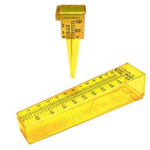A drought and heat wave in the fall of 2019 lead to the death of a number of evergreens, and other landscape plants as well. Rainfall this year has been spotty, but it is now becoming increasingly dry over many parts of the Cincinnati area and watering is becoming increasingly important.
Please remember to water…correctly!
Water once per week, one inch per week, under the entire branch spread, in the absence of rain, May through November. Either rainfall or your watering should equal the one inch per week. Put out a sprinkler and a straight sided soup can or rain gauge and measure one inch per week.
11-inch capacity rain gauge >>>
Taylor rain gauge >>>
Watering: How and when>>>
Watering Trees and Shrubs>>>
Dry 8-14 day outlook:

Cool but dry 3-4 week outlook:















